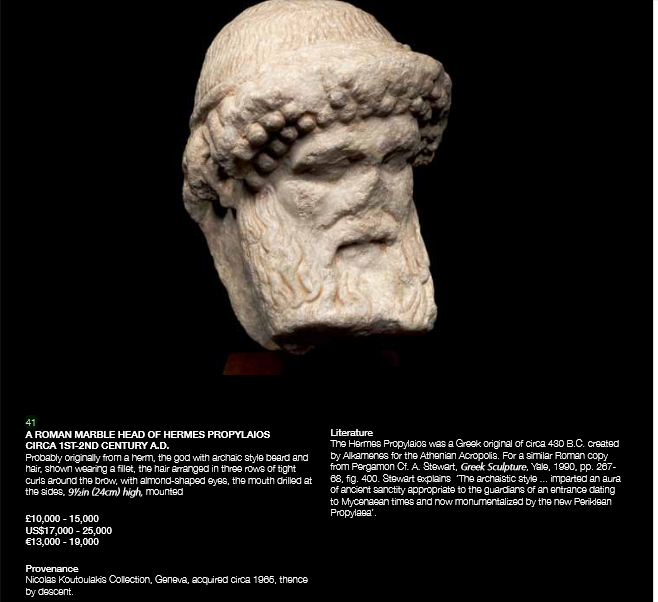Law & Politics
Bonhams Pulls Antique Head from Auction Over Greek Loot Claims


Eileen Kinsella

According to reports on several blogs–including ARCA (Association for Research into Crimes Against Art), Times of Change, and Looting Matters–Bonhams withdrew a Roman marble head of Hermes from its antiquities sale yesterday (October 2) in London after a researcher provided evidence of links to Gianfranco Becchina, who was convicted in 2011 in Italy of dealing in illegal antiquities.
Bonhams withdrew the head, which was estimated at $17,000–25,000 at the request of Greece’s Directorate of Documentation and Protection of Cultural Property of the Ministry of Culture and Sport. The work was displayed in seized photographs showing a possible origin and illegal export from Greece. Christos Tsirogiannis, a research assistant with the Trafficking Culture Project, at the University of Glasgow in Scotland, turned up pictures that were posted on ARCA showing the image in the so-called “Becchina Archives,” a collection of photos and documents confiscated by Italian and Swiss authorities in 2002 and 2005. The archives were particularly damning as they laid out the scope and extent of Becchina’s trade in looted objects.
Tsirogiannis wrote to David Gill of Looted Matters: “The origins of the head is Greece, because it is a Greek looter named Costas Gaitanis…who sent to Becchina on May 29th, 1987, the Polaroids depicting the head.” According to the Bonhams catalogue page prior to withdrawal of the lot, the circa 1st to 2nd century CE head was in the collection of Nicolas Koutoulakis from about 1965, five years prior to the UNESCO Convention that was designed to halt the trade in looted antiquities. The ARCA post cites the revealing 2006 book The Medici Conspiracy, noting that “Nikola [sic] Koutoulakis was an illicit antiquities dealer who has been involved in the trade of several antiquities looted from Greece, Italy, and Egypt after the 1970 Convention, some of which were recently repatriated to the countries of their origin.”
We reached out to Bonhams for comment but were told by a representative: “We are not commenting at this point on the Greek lot that was withdrawn.” Instead, we received a press release and images detailing the withdrawal of a different lot from the sale, albeit with a much happier ending: The “Treasure of Harageh,” a collection of 4,000-year-old artifacts discovered in an Egyptian tomb in 1914, was sold to the Metropolitan Museum of Art in a private treaty sale, for an undisclosed sum, having been taken out of bidding action with a $129–194,000 estimate.